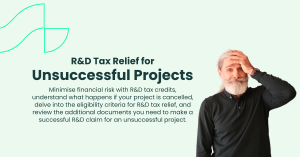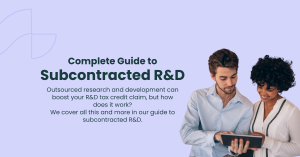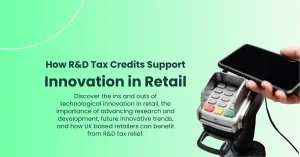Why record keeping is important for maximising R&D tax credit claim
14 November 2023

To unlock the incredible opportunity of R&D tax credits for your innovative business, you need to provide various evidence to HMRC to strengthen your claim and prevent the risk of a time-consuming enquiry. Whether you’re a small startup or a large enterprise, understanding the nuances of effective record-keeping can make all the difference in harnessing the incentives designed to fuel innovation and elevate your business to new heights. This article will guide you through the reasons why record keeping is vital for your R&D tax credit claim and provide practical guidelines on what to include in your records as you carry out your research and development or when you’re claiming retrospectively.
What record-keeping is needed for your R&D tax credit claim?
The purpose of record keeping is to validate your research and development activities to HMRC, helping you to claim for R&D costs to reduce your corporation tax liability and fuel your project. While HMRC does not have a fixed system for record-keeping, they do require proof of your R&D costs as well as project documentation that highlights the activities of your members of staff and how the project evolved through trial and error. Essentially, through your record keeping, you need to demonstrate and show:
- How does your project have the aim of achieving scientific or technological advancement?
- What was the barrier of uncertainty that needed time and resources to overcome?
- How a competent professional in your field could not easily achieve your project. In other words, you were embarking on something new and unknown.
Here are the records you’ll need to keep track of before making an R&D tax credit claim:
The costs of qualifying direct activities
HMRC requires you to show the expenditure of your R&D costs and these need to be separated into direct and indirect activities. Qualifying direct activities refer to the specific research and development tasks and expenditures directly associated with advancing scientific or technological innovation, meeting criteria such as addressing uncertainties, attempting solutions, and requiring specialised expertise. Here are some examples to help you determine what you need to keep financial records of:
- Staff costs for laboratory experimentation, prototype development, software development, design and engineering activities. These financial records should include time-tracking documentation for employees directly engaged in R&D activities to show how long they spent on the projects. You should also describe the job roles and responsibilities of the staff involved in the R&D activities.
- Software costs for engaging in the design and coding of software systems that involve overcoming technical uncertainties or pushing the boundaries of existing technologies. The records required would include invoices and receipts for software purchases or licences directly used in R&D as well as documentation that illustrates how the software is integral to the development or improvement of products or processes.
- The costs of materials and consumables for laboratory experimentation, prototype development, formulation and reformulation, testing and quality control. Just like software records, you’ll need to provide invoices, receipts, and documentation to explain the uses of the materials and consumables in your project(s).
The costs of qualifying indirect activities
On the other hand, indirect activities for R&D tax credits refer to encompass supportive functions and overhead costs that contribute to the overall research and development process but may not be directly engaged in the advancement of scientific or technological innovation, including administrative, managerial, and facility-related expenses. Examples of the financial records you’ll need to keep include:
Staff costs:
- Records of personnel involved in administrative, managerial, or facility-related roles supporting R&D efforts.
- Time-tracking records for staff engaged in indirect activities, demonstrating their contribution to the R&D process.
Overhead costs:
- Documentation of overhead expenses related to facilities, utilities, and other general operational costs.
- Allocation methods or calculations to attribute a portion of overhead costs specifically to R&D activities.
Project management and administration:
- Records of project management activities outlining how administrative tasks contribute to the overall R&D project.
- Documentation of meetings, decisions, and correspondence related to project administration.
Facility costs:
- Lease agreements or documentation related to the use of facilities for R&D activities.
- Utility bills and expenses associated with the facilities used for R&D.
Documentation of the allocation of your staff’s time
As mentioned above, you can claim for staff costs, however only for the time they spent involved in eligible R&D activities. This allocation of time must be fair and well recorded to prevent an enquiry from HMRC. The financial records alone will not showcase this allocation of time. That’s why you need additional records.
The best way to prepare this for your R&D claim is through time-tracking, using some form of time sheet. Include the specific tasks, projects, or phases they were working on during the tracked period. This can be done using software or manually entering into a spreadsheet.
Records of the progress of your project
In addition to time sheets and financial records, there are several other types of records that may need to be included as part of an R&D tax credit claim. The specific requirements can vary by jurisdiction, but generally, these additional records can help substantiate and support your claim:
- Project documentation outlining the objectives, methodologies, and outcomes of the R&D projects. This can include project plans, progress reports, and any changes made during the project.
- Records related to the development and testing of prototypes, including design documents, testing protocols, and outcomes. This demonstrates the practical application of R&D efforts.
- Records of testing protocols, results, and quality control procedures, demonstrating the efforts to ensure products meet specified criteria and regulatory standards.
- Documentation illustrating how R&D projects comply with relevant regulations, standards, or industry requirements. This is particularly important for projects addressing regulatory challenges.
- Documentation of meetings related to R&D projects, including notes, decisions made, and any correspondence. This provides insight into the collaborative nature of the projects.
Clarify how you worked with third-party workers
You can claim the costs for Externally Provided Workers (EPWs) and subcontractors to cover the time they spent engaged in the R&D activities of your project. You should keep records of contracts or agreements outlining the scope of work, invoices from external providers, and evidence of payments made. Additionally, maintain documentation that clearly demonstrates the specific contributions of EPWs and subcontractors to the R&D projects, including project plans, progress reports, or other relevant project-related records. These records serve to substantiate the eligibility of external costs and support the overall R&D tax credit claim.
What if you’re claiming retrospectively because you weren’t aware of R&D tax credits?
There are many circumstances where businesses carry out their endeavours and find out later down the line that they can claim R&D tax credits. This is something we find a lot at Alexander Clifford as not only does our mission involve simplifying the claiming process but also finding eligible businesses to extend the message of R&D to so they don’t miss out on the opportunity.
The good news is that HMRC is lenient regarding these cases for first-time claimants. They understand that without the awareness of the R&D incentives, you most likely won’t be keeping all these detailed records as you carry out your project.
If you’ve recently discovered the potential for R&D tax credits, it’s crucial to start organising and collecting any available documentation related to your qualifying activities. Begin by compiling project details, financial records, and any evidence of innovation or challenges faced. While comprehensive records enhance your claim, HMRC often considers a reasonable effort to gather available information. Seeking guidance from R&D tax specialists can streamline the process of joining the dots, ensuring you maximise your claim while navigating the necessary documentation requirements. The collaboration with a specialist significantly contributes to a successful and well-supported claim, even for first-time applicants.
Best practices for record-keeping to maximise R&D tax credit claim
Here are some top tips to have in mind to guide you through record keeping:
Have a meticulous mindset
A meticulous mindset in R&D record-keeping ensures attention to detail, thorough documentation, and consistency, enhancing the accuracy and efficiency of the claim process. It promotes organised systems, proactive error detection, and adaptability, allowing for efficient retrieval and forensic analysis if needed. Keeping and storing all records streamlines the entire claiming process, saving you time in the long run. If HMRC requests any additional information, you can easily find it and send it to them.
A way to help you is to conduct regular internal audits of your records to identify and address any discrepancies or gaps. This proactive approach helps maintain the integrity of your documentation.
Get into the practice of updating your records regularly
A key part of R&D eligibility is showing how you encountered trial and error. So by keeping a journal to log everything, you’ll see the evolution of your team’s thinking with details of the various challenges you come across. This is particularly useful when you prepare your claim for quite some time after the completion of the project. It’s natural to forget the little details however these are the details that will flesh out your technical narrative with accuracy and really bring your claim to life. The more detail, the better!
The staff involved in R&D should be keeping these notes and they should be stored somewhere accessible for the person completing the claim. They also help you to identify what each member of your team worked on, and their day-to-day responsibilities.
Have future claims in mind
It’s very common for R&D projects to run into the next financial year meaning there could be 2 more claims to complete overtime. Organised records will also benefit your future claims so you don’t have to start the entire claiming process from the very beginning. If you get this bit right, your next one will be a lot easier and you won’t need to rely on memory to complete the claim.
Use consistent naming
Use consistent and clear naming conventions for files, documents, and records. This makes it easier to locate and cross-reference information.
Version control
Implement version control for documents and project files. Clearly label different versions and track changes to maintain a chronological record of project evolution.
Seek expert advice
Engage with R&D tax specialists or professionals to ensure your record-keeping aligns with specific regulatory requirements. They can provide valuable insights and guidance on optimising your claim.
The Alexander Clifford team are here to help you piece your claim together, fast-tracking the process in a streamlined way. Our track records have resulted in thousands of successful claims for clients across various industries.
If you want a bespoke consultation on your record-keeping mechanism to maximise the success of your claim then get in touch.
Final thoughts
The key to receiving tax credits is to maintain efficient processes for record-keeping for your R&D tax credit claim. Embracing best practices, such as a meticulous mindset, regular updates, and forward-thinking record-keeping, ensures that businesses not only meet HMRC requirements but also position themselves for seamless future claims. As businesses embark on the journey of innovation, strategic record-keeping emerges as the key to unlocking the doors to R&D tax credit benefits, propelling them toward a future of sustained growth and financial advantage. Contact us to get started on your R&D claim.







